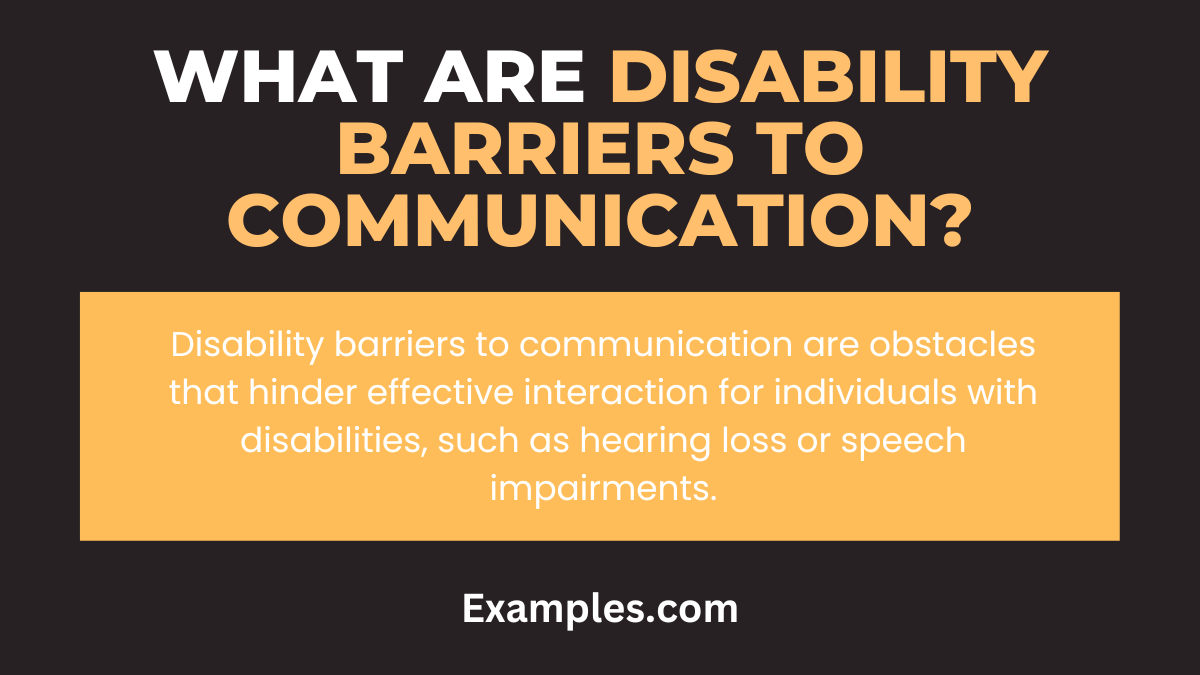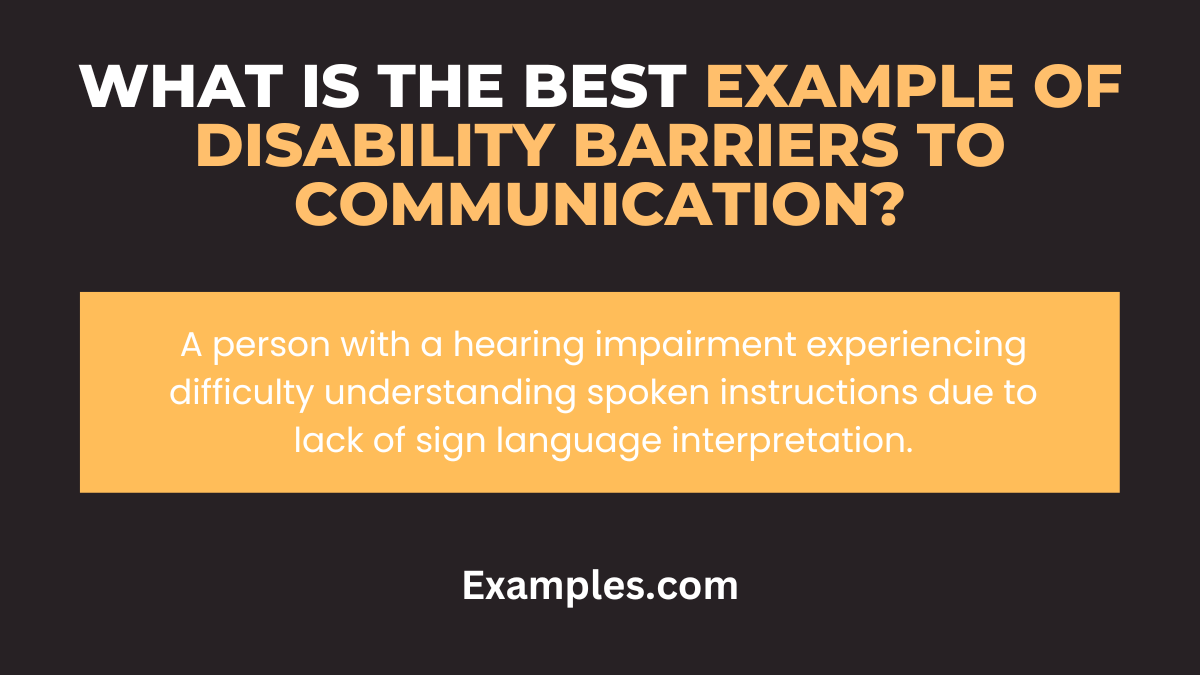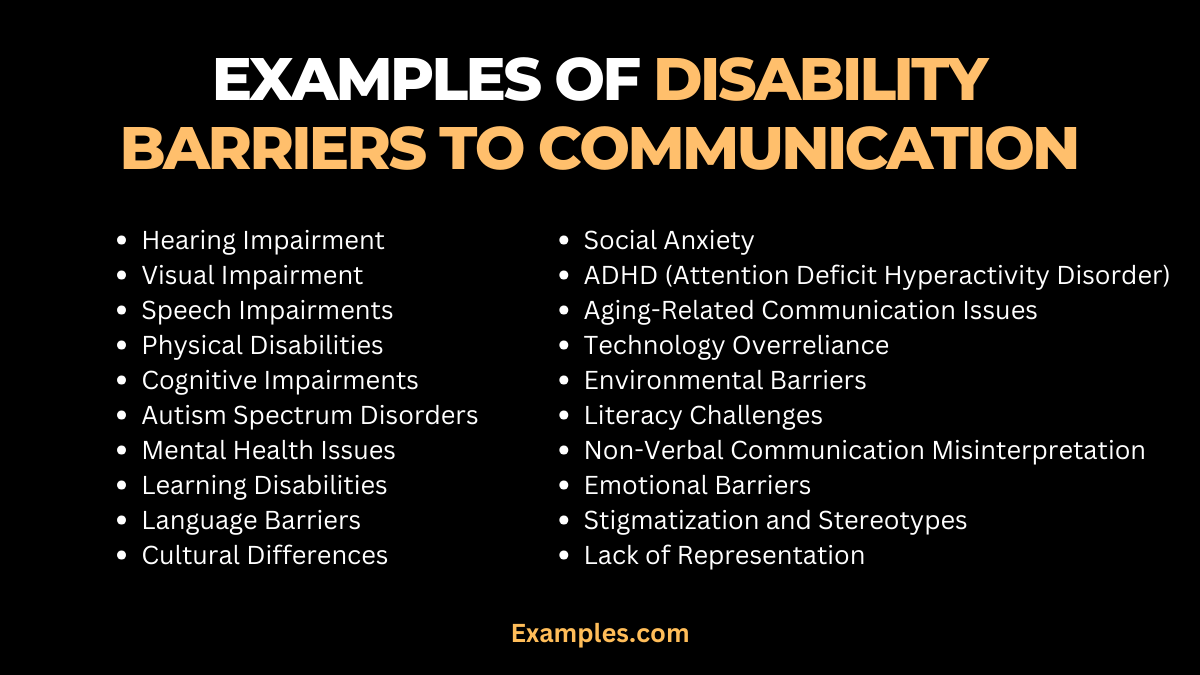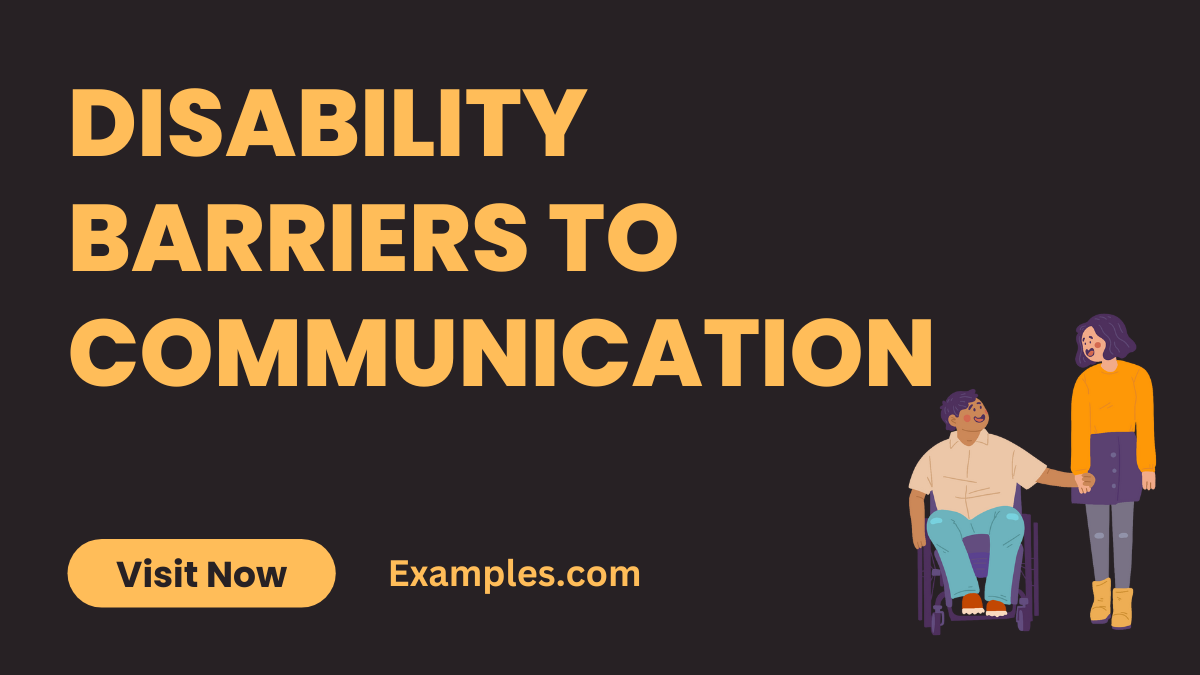19+ Disability Barriers to Communication Examples
Navigating through the complex landscape of disability barriers to communication requires understanding and empathy. This comprehensive guide delves into the multifaceted nature of these barriers, ranging from physical to psychological challenges. It aims to shed light on how these barriers impede effective communication, offering practical examples and tips to overcome them. Whether in personal interactions or professional settings, this guide is an essential resource for fostering more inclusive and effective communication practices, aligning with the broader goal of understanding barriers of communication in diverse contexts.
What are Disability Barriers to Communication?

Disability barriers to communication refer to the challenges faced by individuals with disabilities in effectively exchanging information, ideas, or feelings with others. These barriers can be physical, sensory, cognitive, or emotional in nature. For instance, a person with a hearing impairment might struggle with traditional verbal communication, while someone with a cognitive disability may find it difficult to understand complex language or expressions. These barriers often require alternative methods or tools to facilitate effective communication, ensuring that individuals with disabilities can participate fully and effectively in interactions.
What is the Best Example of Disability Barriers to Communication?

A prime example of a disability barrier to communication is hearing impairment. Individuals with hearing loss face significant challenges in traditional verbal communication settings. They may struggle to understand spoken words, especially in noisy environments or when the speaker is not facing them. This barrier impacts not only the comprehension of speech but also affects their ability to participate in conversations, leading to feelings of isolation or exclusion.
One common solution to this barrier is the use of sign language, a visual means of communication using hand gestures, body language, and facial expressions. However, not all people with hearing impairments are fluent in sign language, and not all hearing people understand it, which can further complicate communication. Additionally, assistive technologies like hearing aids or cochlear implants can help, but they don’t always fully overcome the barrier, especially in cases of profound hearing loss.
Moreover, the lack of public awareness and accommodations for different communication styles and technological barriers in communication can exacerbate the challenges faced by those with hearing impairments. For instance, the absence of sign language interpreters in public events or services can limit their access to information and participation in community activities.
20 Examples of Disability Barriers to Communication

1. Hearing Impairment
Description: Hearing impairment can significantly hinder verbal communication. Utilizing sign language, written communication, and hearing aids are essential strategies to facilitate interaction.
Example: “I will write down key points for clarity.”
2. Visual Impairment
Description: Challenges in accessing visual communication mediums like signs or written text are common for individuals with visual impairment. Using audio descriptions and Braille are effective solutions.
Example: “Let me provide an audio description of the chart.”
3. Speech Impairments
Description: Speech impairments can make verbal communication difficult. Employing alternative communication methods like gestures or communication boards helps in bridging this gap.
Example: “I’ll use this app to type what I want to say.”
4. Physical Disabilities
Description: Physical disabilities may limit an individual’s ability to access certain communication environments. Ensuring physical accessibility and comfortable settings is crucial.
Example: “Let’s meet in a wheelchair-accessible location.”
5. Cognitive Impairments
Description: Cognitive disabilities can affect the processing of information. Simplifying language and providing clear, concise instructions aids in effective communication.
Example: “I’ll explain this step-by-step for clarity.”
6. Autism Spectrum Disorders
Description: Individuals on the autism spectrum might have unique communication needs, including preferences for non-verbal communication. Patience and understanding their communication style are key.
Example: “Would you prefer using pictures to communicate?”
7. Mental Health Issues
Description: Mental health conditions can impact communication. Creating a supportive environment and being empathetic are essential. Example: “I’m here to listen whenever you’re ready to talk.”
8. Learning Disabilities
Description: People with learning disabilities might require more time to understand or communicate. Using straightforward language and visual aids can be helpful.
Example: “Let’s go over this together, step by step.”
9. Language Barriers
Description: For individuals with limited proficiency in the dominant language, providing translation services or using simple, clear language is important.
Example: “I can get a translator to assist us if needed.”
10. Cultural Differences
Description: Cultural differences in communication can create misunderstandings. Being culturally sensitive and aware of non-verbal cues is vital. Example: “I respect your cultural practices and want to communicate accordingly.”
11. Social Anxiety
Description: Social anxiety can inhibit one’s ability to communicate effectively. Offering a safe, non-judgmental space encourages open communication.
Example: “It’s okay to take your time; I’m here to listen.”
12. Attention Deficit Hyperactivity Disorder (ADHD)
Description: ADHD can affect an individual’s focus and communication. Providing concise, engaging communication helps in maintaining their attention.
Example: “Let’s focus on one topic at a time for better understanding.”
13. Aging-Related Communication Issues
Description: Age-related changes can affect hearing, sight, and cognitive abilities. Patience and adapting communication styles accordingly are necessary.
Example: “I will speak slowly and clearly for your comfort.”
14. Technology Overreliance
Description: Overdependence on technology can be a barrier for those not proficient with digital tools. Offering alternatives to digital communication is important.
Example: “Would you prefer a phone call instead of an email?”
15. Environmental Barriers
Description: Inadequate lighting, noise, and uncomfortable settings can hinder communication for people with disabilities. Creating an appropriate environment is essential.
Example: “Let’s find a quieter place for our conversation.”
16. Literacy Challenges
Description: Low literacy levels can impede understanding of written communication. Using oral communication and visual aids can be effective. Example: “I can explain this orally if that’s easier for you.”
17. Non-Verbal Communication Misinterpretation
Description: Misinterpreting non-verbal cues can lead to misunderstandings, especially for individuals with certain disabilities. Clarifying intentions verbally is helpful.
Example: “Just to clarify, my nod means I agree with you.”
18. Emotional Barriers
Description: Emotional distress can impact the ability to communicate effectively. Recognizing emotional states and showing empathy is crucial. Example: “I understand this might be upsetting, let’s discuss it when you’re comfortable.”
19. Stigmatization and Stereotypes
Description: Stigma and stereotypes can create communication barriers by fostering environments where individuals feel misunderstood or marginalized.
Example: “I want to understand your perspective without any preconceived notions.”
20. Lack of Representation
Description: The absence of representation in media and communication platforms for people with disabilities can lead to feelings of isolation and miscommunication.
Example: “We should include diverse representations in our communications.”
What are the Barriers Faced in Communication by People with Disability?
1. Physical Barriers
Physical barriers, such as lack of accessible communication tools for people with mobility or sensory impairments, can hinder effective communication. This includes environments not equipped with ramps, Braille signage, or hearing loops.
2. Technological Barriers
For those with disabilities, inadequate access to adaptive technologies like speech-to-text software or screen readers can be a significant barrier. This technological barrier to communication limits their ability to interact in digital spaces.
3. Language Barriers
People with cognitive disabilities may face challenges with complex language or jargon. Simplified language and clear instructions are often needed to facilitate understanding.
4. Attitudinal Barriers
Stereotypes and misconceptions about disabilities can lead to attitudinal barriers. These can manifest as underestimation of capabilities or over-simplification of communication, which may feel patronizing.
5. Sensory Barriers
Individuals with visual or hearing impairments encounter sensory barriers. Lack of sign language interpreters or alternative formats for visually impaired individuals (like audio descriptions) can impede communication.
6. Information Overload
Information overload in communication can be particularly challenging for individuals with learning disabilities. Too much information at once can be overwhelming and difficult to process.
7. Psychological Barriers
Anxiety, low self-esteem, or lack of confidence, often stemming from past negative experiences, can be major psychological barriers in communication for people with disabilities.
8. Cultural and Social Barriers
Cultural and social misconceptions about disability can lead to exclusion or inappropriate communication methods, creating barriers in social and professional interactions.
How to Overcome Disability Barriers to Communication?
1. Utilizing Assistive Technologies
Embracing technologies like text-to-speech tools, hearing aids, and Braille displays can significantly improve communication for those with disabilities.
2. Adopting Clear and Simple Language
Using clear, concise, and jargon-free language helps in making communication more accessible for individuals with cognitive or learning disabilities.
3. Enhancing Environmental Accessibility
Modifying environments to be more disability-friendly, such as installing ramps, tactile paving, and providing materials in Braille or large print, can reduce physical barriers.
4. Offering Alternative Communication Methods
Providing alternatives like sign language interpretation, text messages, or visual aids can help overcome sensory barriers for those with hearing or visual impairments.
5. Promoting Awareness and Sensitivity Training
Educating the public and professionals about disability and effective communication strategies can reduce attitudinal barriers and misconceptions.
6. Ensuring Information is Digestible
Breaking down information into smaller, manageable parts can help people with learning disabilities process it more easily, addressing the issue of information overload in communication.
7. Supporting Psychological Well-being
Creating a supportive and understanding environment can help alleviate psychological barriers, encouraging individuals with disabilities to communicate more openly and confidently.
8. Encouraging Cultural and Social Inclusivity
Promoting inclusivity and cultural sensitivity in communications can help break down social barriers, leading to more effective and respectful interactions.
Addressing these barriers requires a concerted effort from individuals, communities, and organizations to ensure that communication is inclusive and accessible for everyone, regardless of their abilities.
Types of Barriers that Impact People with Disability
1. Physical Barriers to Communication
Physical barriers are one of the most significant challenges for individuals with disabilities. These include inaccessible meeting spaces or buildings and lack of appropriate assistive tools for communication, such as hearing aids or screen readers, hindering effective interaction.
2. Language Barriers to Communication
Language barriers can be particularly challenging for those with hearing impairments or cognitive disabilities. The absence of sign language interpreters or simplified language materials can severely limit their ability to communicate effectively.
3. Psychological Barriers to Communication
Psychological barriers, such as anxiety or low self-esteem, often affect people with disabilities. These barriers can stem from societal attitudes or personal experiences, making it difficult for them to express themselves confidently.
4. Cultural Barriers to Communication
Cultural differences in communication can create misunderstandings or misconceptions. People with disabilities may face stereotypes or biases based on cultural norms, impacting how others communicate with them.
5. Emotional Barriers to Communication
Emotional barriers, like fear or embarrassment, can impede open communication. For someone with a disability, these feelings might arise from past negative experiences or a fear of being judged.
6. Gender Barriers to Communication
Gender can influence how people with disabilities are communicated with. Gender barriers to communication may lead to differing expectations or biases in the way information is conveyed or received, affecting the clarity and effectiveness of the communication.
7. Technological Barriers to Communication
In the digital age, technological barriers are significant. Lack of access to or familiarity with digital communication tools can leave those with disabilities at a disadvantage, especially in environments where digital communication is prevalent.
8. Perceptual Barriers to Communication
Perceptual barriers arise from the way individuals with disabilities perceive the world and how they are perceived by others. Misunderstandings due to different perspectives or lack of awareness about disabilities can hinder effective communication.
Addressing these barriers requires a concerted effort to understand and adapt communication methods to be inclusive and accessible for all individuals, regardless of their disabilities. This includes providing the necessary tools, resources, and understanding to facilitate effective and respectful communication.
Understanding and addressing disability barriers to communication is crucial for inclusive and effective interaction. Whether it’s adapting to physical barriers like visual or hearing impairments, or navigating psychological and cultural differences, recognizing these challenges is the first step. By employing empathetic, patient, and innovative communication strategies, we can overcome these barriers, ensuring everyone has the opportunity to be heard and understood.



